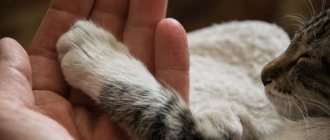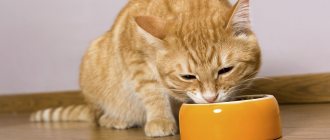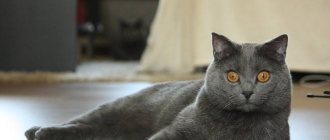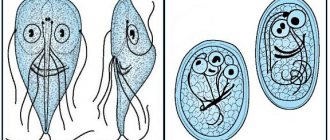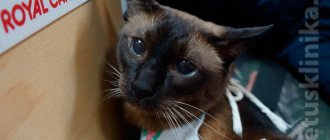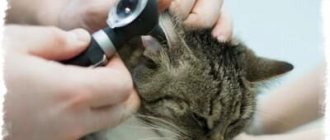When faced with arthritis or arthrosis, cats begin to experience severe pain and stiffness when moving, lifting and jumping even to low heights. These diseases cannot be neglected - they can lead to irreversible consequences. What are the symptoms of arthritis and arthrosis in cats? What is the treatment? Find answers to these and other questions below.
Read in this article:
What is this? At-risk groups
Causes of arthritis and arthrosis
Symptoms of joint damage
Diagnosis of the condition
Treatment of arthritis and arthrosis
Causes of arthritis and arthrosis
The development of arthrosis is most often caused by a violation of vitamin and mineral metabolism, incorrect positioning of the limbs, as well as anomalies affecting the articular surfaces. Arthritis often occurs when the immune system is dysfunctional (for example, when a pet is exposed to the cold for a long time).
Other common causes of arthritis and arthrosis in cats:
- Injuries
Various injuries (for example, an unsuccessful landing from a height, a fall, torn ligaments) can cause the development of arthritis or arthrosis, since ligaments are injured along with bones and internal organs.
- Metabolic disorders
Improper metabolism of substances, vitamins and minerals in the pet’s body leads to weakening of the joint tissue. It is not renewed due to an insufficient amount of “building materials” in the body.
- Age-related changes
Osteoarthritis is often diagnosed in older cats, since the joints quickly wear out and practically do not recover. Owners whose pets suffer from obesity need to be especially careful.
- Overweight
Most often, obesity is provoked by poor nutrition and lack of physical activity (usually in domestic cats). Excessive weight puts a lot of stress on the joints, which are not always able to withstand it.
- Genetic predisposition
Some diseases of the musculoskeletal system are transmitted genetically (for example, dysplasia of the elbow or hip joint). It is recommended to begin veterinary observation of such pets at a young age.
- Infectious diseases
A number of infections affect the joint tissues of the body, slowing down their subsequent renewal and causing inflammatory processes. Thus, the disease can develop against the background of viral hepatitis, chlamydia or bronchitis.
The most common diseases
If a cat suffers from discomfort, the owner also feels it, because the once affectionate and playful pet demonstrates apathetic behavior, eats poorly, and loses interest in what is happening. In such situations, the following pathologies may appear:
Ingrown claws
In order for the claws to be naturally cleared of the old stratum corneum and to always be of optimal length and shape, the animal needs to constantly scratch something, climb trees, and walk on hard surfaces. However, in home conditions, fulfilling these requirements is impossible or difficult. Representatives of the cat family, especially representatives of inactive large breeds, cannot sharpen their claws and become members of the risk group.
Prevention and treatment measures consist of the following: In the room where the furry family pet lives, you need to install a scratching post. There is a huge selection of models on sale in wall, floor and combined formats. If an ingrown claw is detected by the characteristic focus of inflammation that appears on the paw, you must immediately begin drug therapy and remove the excess length of the claw with a special device. Otherwise, the dirt accumulated in the wound will lead to the formation of pus, and the condition will worsen every day - discomfort and severe pain will appear in the affected area.
Cracks on the pads
After mechanical damage and injury, cracks form on the pads and the claws break off. Then purulent inflammation begins in the corolla, and over time the claw falls off on its own.
If this does not happen, surgery is required. The veterinarian will cut away the affected tissue, apply sutures, and cover the affected area with a sterile bandage. Simple actions can help minimize risk. It is important to avoid making the claws too sharp and long, and if they are damaged, wash the paws in a solution with an antiseptic effect, which will remove bacteria and relieve inflammation.
Foreign body entry
If your pet constantly limps, hides its paw under its body and licks it for a long time, you can suspect that a foreign body has entered the tissue. A foreign object not only causes pain and inconvenience, but also increases the likelihood of serious infections being introduced into the body.
The foreign body must be removed without delaying the time of seeking help from a specialized veterinary clinic. If treatment is not started, the inflammatory process increases, the virus penetrates the subcutaneous tissue, affects tendons and joints, causing such terrible consequences as amputation of a limb. When you notice the first signs of an illness, you need to make an appointment with a specialist who will perform an examination in the office, prescribe an x-ray or other types of diagnostics and studies.
Inflammation of the corolla
After severe bruises, wounds and blows in different parts of the front and hind legs, the corolla becomes inflamed. The disease also appears against the background of the consequences of previous infectious processes. If the condition is advanced, a procedure for extirpation of the claws and sometimes the phalanges of the fingers is required. After it, the cat will limp, but will be able to live its previous life and remain physically active.
Treatment of mild cases of inflammation of the corolla involves other directions:
- warm baths with antiseptic drugs
- applying dressings soaked in disinfectants
- medicines
To recognize a problem, you need to know exactly the nature of its manifestations. The most pronounced symptoms are staggering and rejection of the claws, loss of their shine and rigidity, pain and swelling of the fingers.
Pododermatitis
The most common reason for a visit to a veterinary clinic is inflammation of the soft tissues on the pet’s paws. The disease is called pododermatitis, and is manifested by the following symptoms:
- the gait becomes uncertain and shaky, steps are difficult
- pain and discomfort bother you when moving
- visually the pads appear swollen and inflamed, they may have ulcers and cracks
Due to unpleasant sensations, the cat begins to exhibit aggressive behavior that is unusual for it, it develops nervousness, and its stress level rises daily. To help the animal, it is important to sound the alarm in the first stages of disease progression and not ignore the above symptoms. If you miss a critical moment, you may encounter irreversible changes.
Pododermatitis appears under the influence of various negative factors:
A. Hypothermia
If your pet sleeps in a draft, walks in inclement weather, or after bathing enters a room without heating, there is a high risk of hypothermia.
B. Exposure to chemical environment
In the off-season and winter, pedestrian paths and driveways are sprinkled with chemicals that prevent the surface from freezing. If a cat walks along such routes, aggressive substances fall on the paws, penetrate the skin and irritate it, triggering necrotic processes in the tissue structure.
B. Allergic reactions
Allergens have an adverse effect on health and well-being. They cause dermatitis, and cats with a low immune response in the body cannot resist the disease.
D. Pathogenic bacterial infection
The bacterial environment enters the body through various skin injuries - cuts, wounds, abrasions. The result is the appearance of a fungal disease on the paws, which becomes chronic without treatment. With mycoses, the skin flakes and itches, and the cat makes attempts to shake off its paws. Due to severe, irrepressible itching, extensive wound surfaces appear, and the pet becomes restless and irritated.
D. Autoimmune diseases
Pododermatitis can be a consequence of past autoimmune diseases. It progresses in young and adult cats, but cats with excess body weight, as well as weakened pets with an incorrectly structured diet and a passive lifestyle, are most susceptible to the disease.
Owners can find out that the soft tissues on their paws are inflamed by the following signs:
- the cat spends more time on hygiene - constantly licks its paws
- the pads feel unusually soft to the touch, lose their elasticity and shape
- specks of blood appear on the surface of the integument
If these symptoms are missed, necrosis may develop on the paws, which is accompanied by sepsis. In advanced cases, even the most experienced and professional veterinarians do not guarantee a high probability of the cat’s survival, because the methods known in medicine are ineffective in severe conditions.
Symptoms of joint damage
The first thing you will notice when a cat develops arthritis or arthrosis is behavioral changes. If before the pet loved to run, jump and play, now he takes care of his paw and avoids stress. At stages II and III of the disease, the animal experiences pain even when moving short distances (for example, from one room to another).
The main symptoms of arthritis and arthrosis in cats:
- Soreness . It is observed in the affected area, while the pet becomes angry if someone tries to touch it, and meows loudly;
- Stiffness . The animal loses motor activity and rests more often. Begins to walk slowly and limp;
- Edema . There is swelling in the problem area. The cat's body temperature rises, especially with severe pain;
- Crunch . Due to the destruction of the layer between the cartilages, strong friction of the bones occurs, so when the cat moves, a specific crunching sound (rough, dry clicking) may be observed.
Note! Arthritis and arthrosis negatively affect the appearance of the pet. Because of the pain, he practically stops caring for his fur: it becomes dirty and gets tangled.
Life After Trauma: Recovery
The recovery of a cat after an injury depends on how severe the damage was, how many and which organs were damaged, whether first and subsequent veterinary care was provided and how quickly this was done. That is, the recovery period depends on many factors and in each specific case may take different times and require different treatment. The only thing that remains unchanged is that any incident, even a seemingly insignificant one, must be monitored by a specialist. If your pet falls, gets hit by a car, gets stuck in a window, or gets into a fight, take it to the doctor. The clinic will always treat such a visit with understanding and will do everything possible to keep your cat healthy and active.
Diagnosis of the condition
If you notice one or more symptoms in your cat, do not hesitate to contact your veterinarian. The sooner you start treatment, the faster your pet will return to a healthy life. Diagnosis of the condition begins with an initial examination.
The specialist pays attention to the condition of the animal’s coat and the position of the hind limbs. A diagnosis can only be made after the veterinarian observes the cat in motion. Additionally, joints are palpated to identify:
- swelling,
- soreness,
- deformation.
The most common diagnostic method is radiographic examination. The resulting images will show changes in the articular tissue, indicating degenerative changes.
Car injuries in cats
The most dangerous type of injury, since when a cat gets under the wheels of a car, it suffers multiple injuries, both external and internal. It is very rare that such situations do not have serious consequences. If an accident occurs with an animal, it must be immediately taken to the nearest veterinary clinic. The first aid that the owner can provide in such a situation is limited to applying a tourniquet or tight bandage in the presence of bleeding, as well as fixing the pet in one position as much as possible. Already in the hospital, the doctor will be able to determine the presence of internal injuries that may require emergency surgical treatment, fractures of the bones of the limbs, and the spine. Injuries sustained in a car collision require long-term stabilization of the patient’s condition, compensation for blood loss, which most often accompanies them, and other special treatment measures.
Treatment of arthritis and arthrosis
How to treat arthritis in a cat? The first and most important rule is do not self-medicate! Therapy of joint tissue diseases requires professionalism and experience, so entrust the treatment to qualified veterinarians in Moscow.
They will determine the cause of arthritis or arthrosis, and then select effective therapy aimed at eliminating it. Additionally, maintenance treatment is prescribed using chondroprotectors and non-steroidal anti-inflammatory drugs.
In addition to drug therapy, it is important to monitor your pet’s weight. If your cat is obese, be sure to put him on a low-calorie diet. This may include:
- lean meat,
- sea fish,
- low-fat fermented milk products,
- porridge on the water,
- boiled vegetables.
Don't forget about regular checkups at the veterinary clinic!
Description of the drug Bonharen
The active substance of the drug is hyaluronic acid (in the form of sodium hyaluronate), which is the main element of cartilage tissue and synovial fluid. According to research, with inflammatory changes in the joints, its content decreases, which leads to disruption of the viscosity of the synovial fluid and the strength of chondrocytes. Additional administration of hyaluronic acid for arthritis in animals helps to compensate for its deficiency and reduce the wear and tear of the joint.
The main indications for prescribing Bonharen to cats are:
- acute and chronic arthritis/polyarthritis;
- osteoarthritis;
- arthrosis;
- tendovaginitis;
- bursitis.
The drug is also used for inflammation and injury to the eyeball in animals in order to restore normal metabolism in the organ.
Release form: sterile solution for subcutaneous or intravenous administration. Sold in ampoules of 2 and 6 ml. There are 3 ampoules in the package.
Recommended dosage for cats:
- with a weight of less than 5 kg – 0.1 ml/kg, which corresponds to 1 mg/kg;
- with a weight of more than 5 kg - 0.05 ml/kg, which corresponds to 0.5 mg/kg.
When administered parenterally, the effect of Bonharen is observed after 4 hours, and the total period of activity is 2-3 days. The course of application is from 3 to 7 injections, which must be performed every 5-7 days. The drug can be prescribed to pregnant and lactating cats. There are no contraindications to it. As a side effect, veterinarians note the appearance of a local reaction to the injection, which manifests itself as swelling and disappears after 1-2 days.
Why does it hurt
The ankle is the articulation of three bones - the fibula, tibia and talus. They are all connected to tendons. Around it there are many muscles responsible for flexing the sole. If mechanical or degenerative damage occurs in this structure, pain occurs.
Most often, the ankle joint hurts for the following reasons:
- ankle arthrosis;
- arthritis due to partial or complete dislocation;
- gout;
- tendinitis;
- tunnel syndrome;
- heel bone fracture;
- pathology of the anatomical structure of the joint.
People who lead a sedentary lifestyle are most susceptible to ankle diseases. Ligaments and muscles become flaccid, lose the ability to exercise, and therefore react to them with dislocations, sprains and fractures. Also at risk are people with increased body weight, flat feet, the elderly and athletes.
Arthrosis is not the only possible cause of pain in the ankle joint
In what cases is specialist help for pain urgently needed?
You should not delay contacting a doctor under the following symptoms and circumstances:
- the ankle joint hurts and is very swollen, because of this you are unable to put on shoes;
- due to intense pain you cannot lean on your leg;
- noticed instability of the ankle, loosening (occurs with complete or partial rupture of the ligaments);
- pain occurs when you stand;
- the soreness is felt not only in the muscles, but also deep in the ankle.
Severe pain in the ankle is not a reason to try traditional medicine
A kitten has a bruised paw: why is contacting our veterinarian the right decision?
Any mechanical damage, regardless of the cause, and a bruised paw in a kitten, is stressful for the animal and often causes serious problems later. In some cases, even a slight bruise of the first and second degrees does not go away without a trace for the cat.
If a kitten or adult cat has injured its paw and is limping, then a timely visit to the YA-VET veterinary emergency center will help deal with the injury as quickly as possible without consequences and expensive treatment.
. Correct diagnosis and qualified assistance from veterinarians who have extensive experience working with cats of any age guarantee that the injury will go away as soon as possible, and the pet will enjoy excellent health and the same activity!
We have everything necessary to ensure that mechanical damage to the limbs occurs with the least risk. Veterinary center specialists will find out why the animal is limping and prescribe effective treatment for a specific case. Veterinarians have modern diagnostic equipment, a full-fledged hospital, and their own laboratory at their disposal.
Call us and find out how much emergency veterinary care costs in order to order a visit from specialists without overpayments!
